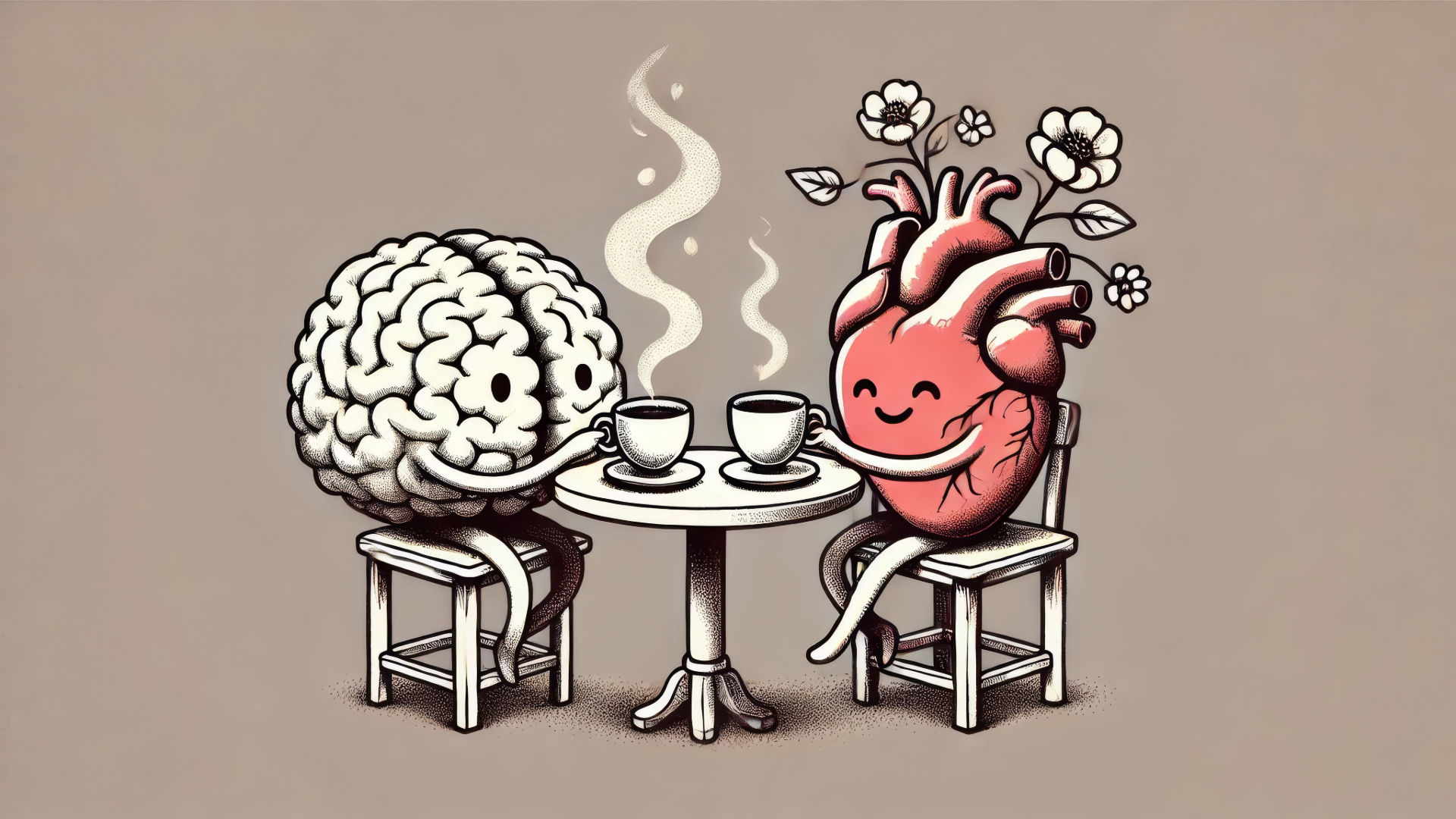Brain-Heart Coherence

The Heart Has its Own Intelligence
The heart is not just a pump for circulating blood, but has it’s own intelligence. It’s a complex and highly sensitive organ capable of processing information, sensing emotions, and even influencing cognition. Apart from being our center of wisdom and inner knowing, recent studies have highlighted the neurocardiac system, where the heart contains its own network of neurons, sometimes referred to as the heart’s brain. The heart contains about 40,000 neurons, which are capable of processing information independently of the brain. These neurons allow the heart to “sense” emotional information, such as love or fear, and send signals to the brain that can impact mood and how we respond to situations.
This communication can affect our stress levels, decision-making, and even our ability to connect with others. So how can we work with this communication for well-being? How can we drop in to our hearts and magnetize everything we desire? This concept is called “Brain-Heart Coherence.” As the heart’s energy expands and vibrates at higher frequencies, it influences the body’s cellular structures through energetic resonance.
What is Brain-Heart Coherence?
Brain-heart coherence refers to a state in which the brain and heart are functioning in harmony. This coherence is marked by a balanced heart rate variability (HRV) and a steady, organized pattern in the heart’s rhythm.
At a physiological level, this coherence is primarily regulated by the autonomic nervous system (ANS), which controls involuntary bodily functions like heart rate, breathing, digestion, and more. The sympathetic nervous system (fight or flight) and the parasympathetic nervous system (rest and digest) are constantly working to maintain balance in the body, and the heart plays a central role in this process.
When we achieve brain-heart coherence, the heart’s rhythms become more smooth and synchronized.
Facts about the heart:
- The heart has an electromagnetic field that is 60 times larger than the electromagnetic field of the brain.
- The heart is more powerful than the brain. It’s about 100,000 times stronger electrically and up to 5,000 times stronger magnetically.
- When you feel love and appreciation in your heart, this energy enlivens you, stabilizes your heartbeat, and heals your entire body.
- When an individual is in heart-coherence, these electromagnetic signals can be detected by the nervous system of other people and animals.
The History of Brain-Heart Coherence
The exploration of brain-heart coherence has roots in neurocardiology. Though the idea of the mind-body connection has existed for centuries in various forms, brain-heart coherence specifically became a focal point in scientific research starting in the 1990s.
The HeartMath Institute: The term “brain-heart coherence” gained significant traction from HeartMath’s work, particularly under the leadership of Doc Childre, the founder. The HeartMath Institute developed techniques and tools, such as the (HRV) monitor. They explored how emotional states, particularly positive ones like love, appreciation, and compassion, could influence heart rhythms and brain function.
The Benefits of Brain-Heart Coherence
Achieving brain-heart coherence has a wide range of benefits. Some of the key benefits include:
1. Emotional Regulation and Stress Reduction
- When the brain and heart are in coherence, emotional states such as anxiety, frustration, and stress are significantly reduced.
2. Enhanced Mental Clarity and Focus
- Improved cognitive function, including better concentration, memory, and problem-solving.
- The synchronized rhythms between the heart and brain create a state of mental clarity and heightened awareness.
3. Improved Physical Health
- Heart coherence has a direct impact on heart rate variability (HRV), which is a key indicator of cardiovascular health.
- Higher HRV is associated with a lower risk of heart disease, better blood pressure regulation, and improved immune system function.
- Coherence can also help balance the autonomic nervous system, reducing inflammation, promoting better sleep, and boosting energy levels.
4. Increased Resilience and Coping Ability
- Brain-heart coherence increases a person’s ability to handle adversity. People in a coherent state tend to recover from stressful situations more quickly and experience less overall emotional turbulence.
- It is believed that by practicing heart-brain coherence, individuals can increase their resilience, enabling them to cope with life’s challenges more effectively.
5. Greater Sense of Well-being
Regularly achieving coherence can lead to a greater sense of inner peace and joy. People who practice heart-brain coherence techniques report feeling more connected to themselves, others, and the world around them.
How to Achieve Brain-Heart Coherence
Here are some ways to synchronize the brain and heart:
1. Deep Breathing (Heart-Focused Breathing or Pranayama)
- Heart-focused breathing is one of the most widely used techniques to achieve coherence. This involves breathing deeply and slowly while focusing on the heart. Typically, you would breathe in for a count of 5 seconds, then breathe out for a count of 5 seconds, while imagining the breath flowing in and out of your heart area.
- This method activates the parasympathetic nervous system, promoting relaxation and coherence between the heart and brain.
2. Practice Positive Emotions (Heart-Focused Emotions)
- Generating positive emotions like love, appreciation, or gratitude can help align the brain and heart. For example, focusing on something you feel deeply grateful for can help produce heart rhythms that are more coherent and synchronized.
- The HeartMath Institute uses a practice called “Quick Coherence”, where you focus on a positive emotion, breathe deeply, and visualize the energy moving through the heart.
3. Meditation and Mindfulness
- Techniques like loving-kindness meditation ( I love the one by Ram Dass ) or body scan meditation can support the alignment of your heart and brain by bringing awareness to the present moment and calm both emotional and physiological responses.
4. Biofeedback Training
- Biofeedback is a technique that uses real-time data (often from a heart rate variability monitor) to help you train yourself to achieve a state of coherence. With biofeedback, you can observe how your heart rate, breathing, and emotions influence one another, helping you learn to control your physiological responses.
5. Exercise and Physical Activity
- Engaging in moderate physical exercise, such as yoga, tai chi, or walking, can help improve heart rate variability and foster brain-heart coherence by reducing stress and promoting overall balance in the autonomic nervous system.
6. Visualization Techniques
- This might involve visualizing your heart beating in a smooth, regular rhythm or imagining positive energy circulating between your heart and brain. Combining this with deep breathing can enhance the effect.
Apart from these techniques, it’s important to take care of the health of your heart. A great food for this is Beet Root. If you want something quicker in supplement form, try this:
Find it on Amazon!

Herbs for the heart: hibiscus, hawthorn, and ginger.
With practice, anyone can work toward achieving a state of brain-heart coherence and experience its profound effects. The more you do something, the more it become second nature. We’re just scratching the surface of the depth of the heart’s intelligence. It’s exciting to see just how much more we can learn about ourselves and how we can self-heal and have all parts of us working in harmony.
A video on breathwork is soon to come.
xx
Diana
Other Sources:
From Frontiers in Psychology
https://www.frontiersin.org/journals/psychology/articles/10.3389/fpsyg.2014.01040/full
From Scientific American Journal
https://www.scientificamerican.com/article/the-heart-brain-connection
Disclaimer:
The health and wellness information provided on Indigo Femme is for informational purposes only. While we strive to offer accurate, up-to-date, and evidence-based content, the information presented should not be construed as medical advice, diagnosis, or treatment. Always consult a qualified healthcare professional before making any changes to your health regimen or lifestyle.



